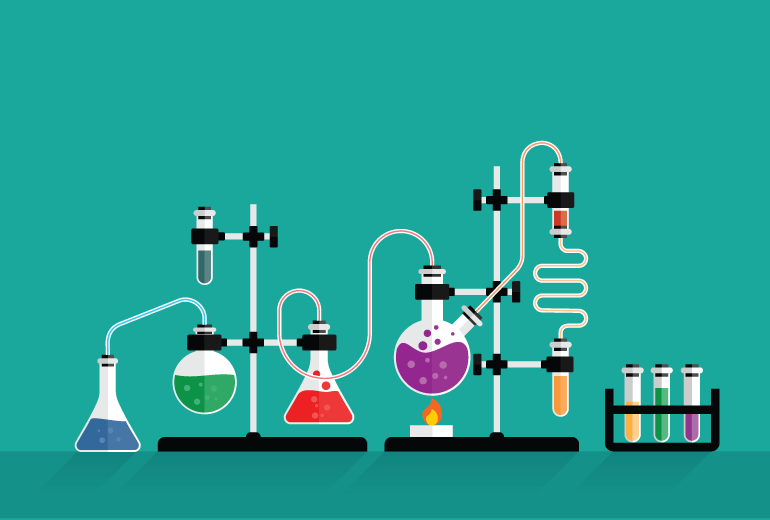A little while back, we posted a recap of a webinar from ACS & C&EN analyzing the top trends of 2018, and what to expect in the year ahead. Now, we want to cast our gaze a bit farther. In a few decades, the world is going to look a lot different, with ubiquitous self-driving cars, refrigerators that double as digital screens, and weekend trips to outer space (sign us up!). While no one can say for sure, our ACS Media Group team asked experts from around the world to share their hopes and predictions for laboratory equipment, the instruments that help scientists… do science. Here is what they had to say:
- 1 → Medical Tricorder. Frances Ligler, a Lampe distinguished professor from the University of North Carolina and North Carolina State University, wants the field of medical diagnostics to boldly go where no one has gone before. In the Star Trek Universe, the tricorder is a handheld device that can scan a patient to provide medical diagnoses within minutes. Ligler predicts that scientists can make this a modern-day reality by improving current microscopy techniques. She says, “I believe we will see cost-effective methods for doing this in the next decade, primarily based on 3D microscopic techniques.” With the help of a medical tricorder, patients will surely be able to live long and prosper.
Learn about scientists’ progress towards handheld medical devices by checking out C&EN’s article about smartphone-based medical diagnostics.
- 2 → Super Magnets. Nuclear magnetic resonance (NMR) spectroscopy is widely used by scientists to obtain structural information about chemical and biological substances.However, this process is often difficult, expensive, and time-consuming. Perhaps that can change, says Damodaran Achary, research professor and director of the NMR facility at the University of Pittsburgh. He wants NMR to become easier and more accessible. Achary says “advancement in structural elucidation software, maybe involving artificial intelligence, could help overcome challenges of analyzing data from complex molecules.” He also wants to simplify the maintenance of the superconducting NMR magnets, which require constant cooling. His ideal instrument would include a magnet powerful enough to study interesting molecules, but would not rely on expensive and increasingly scarce cryogens, such as liquid helium.
Sound familiar? Read more about artificial intelligence and machine learning in our blog post Chemistry Trends You Should Know for 2019.
- 3 → Smart Sensors. Aydogan Ozcan, a professor at University of California – Los Angeles and associate director of California Nanosystems Institute, has a vision of sensors that can be used at any place and at any time. Ozcan says, “We need advanced sensors and measurement instruments that can tolerate harsh environments, like within the body or the ocean, while still being accurate and sensitive.” He says the solution could be ‘thinking sensors,’ which would, using machine learning for example, select a mode of sensing based on task, type of sample, and the environment. These smart sensors could provide quicker and more effective data collection, potentially allowing scientists to probe unfamiliar environments.
Sensory overload! Learn about some of the strides that scientists are making in the field of smart sensors by reading this C&EN article.
- 4 → Handheld Instruments. In the future, science need not be confined to the laboratory, according to Richard Crocombe, consultant and owner of Crocombe Spectroscopy Consulting. He wants to see a handheld gas chromatography–mass spectrometry (GC-MS) instrument. GC-MS can tease out the components of complex mixtures, which makes the instruments well suited to analyze environmental, forensic, and hazardous materials in the field. Portable GC-MS instruments already exist in the present day, but they are way too large and heavy to hold in the palm of your hand. “A true GC-MS handheld,” says Corcombe, “would be a major step forward.”
All hands on deck! Check out C&EN’s article about the first-ever portable mass spectrometer.
- 5 → 3D Printed Devices. Imagine a world where you can print virtually anything you want – food, furniture…analytical sensors? Bhavik Patel, an avid C&EN reader from the University of Brighton, believes 3D printed sensing devices are the way of the future. Patel says, “This technology has been so promising as it provides tremendous scope in the materials and systems that can be explored through analytical measurement.” Patel’s vision includes 3D printed sensors so small they can be incorporated in the human body!
Interested in learning more? Read C&EN’s articles about the increasing popularity of 3D printing technology.
The scientists have spoken and the future of instrumentation looks pretty bright to us at the ACS Media Group 😎 What kinds of scientific instruments would you like to see in the future? Tell us about it in the comments section below.




















